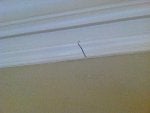Hey guys,
I did a crown molding job a while ago. Out of everything I do, I do this the least. I installed crown in a house without knowing some of the tricks. Gaps developed, they called us back, I THOUGHT I researched the heck out of how to properly install. I went back and reinstalled EVERYTHING again. It's about a 5 inch tall MDF crown, and then there is a little decorative real wood strip about 4 inches under it for an accent. I bought all sticks, took them to the house, let them acclimate for about a week. I did those angled cuts (forgot the name) because I know EVENTUALLY it will still seperate a little. I made sure to shoot the nails into studs. I even placed wood behind the seems where they wouldn't land directly on a stud. I covered the seems this time with wood filler. I used 20 minute mud over top because she was SOOO picky that she didn't want to see the seems at all. It was sanded, primed, painted. You couldn't see anything. Now, not even 2 weeks later, she has sent us pictures showing the gaps again. PLEASE tell me what I am doing wrong and what I need to do to rectify this.
Also, please be specific about products to use and names and locations of where to get them. I live in California.
Thanks SO much for the help in advance. I want to get done with this and I want her to be happy, so any assistance is greatly appreciated.
Thank you!
I did a crown molding job a while ago. Out of everything I do, I do this the least. I installed crown in a house without knowing some of the tricks. Gaps developed, they called us back, I THOUGHT I researched the heck out of how to properly install. I went back and reinstalled EVERYTHING again. It's about a 5 inch tall MDF crown, and then there is a little decorative real wood strip about 4 inches under it for an accent. I bought all sticks, took them to the house, let them acclimate for about a week. I did those angled cuts (forgot the name) because I know EVENTUALLY it will still seperate a little. I made sure to shoot the nails into studs. I even placed wood behind the seems where they wouldn't land directly on a stud. I covered the seems this time with wood filler. I used 20 minute mud over top because she was SOOO picky that she didn't want to see the seems at all. It was sanded, primed, painted. You couldn't see anything. Now, not even 2 weeks later, she has sent us pictures showing the gaps again. PLEASE tell me what I am doing wrong and what I need to do to rectify this.
Also, please be specific about products to use and names and locations of where to get them. I live in California.
Thanks SO much for the help in advance. I want to get done with this and I want her to be happy, so any assistance is greatly appreciated.
Thank you!






